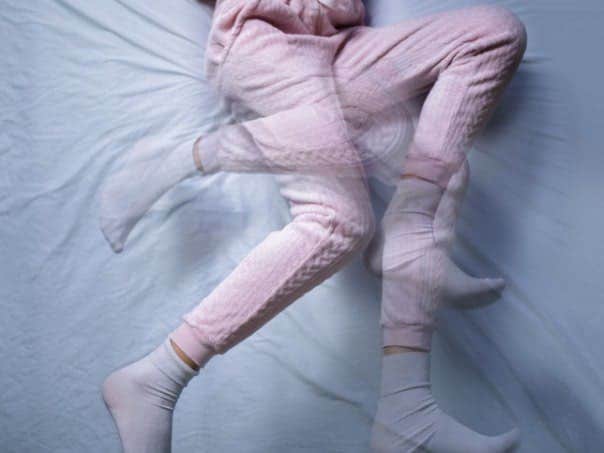Sleep Health
Published January 29, 2022
14 minRestless Leg Syndrome: Symptoms, Causes, Treatment
The syndrome also known as the “Ekbom’s disease” was coined as the Restless Leg Syndrome by Professor Karl-Axel Ekbom in 1944. It is considerably different from the normal shaking of the legs.

Table of contents
What Is Restless Leg Syndrome?Restless Leg Syndrome SymptomsCauses of Restless Leg SyndromeWhat Are the Risk Factors For Restless Leg SyndromeHow is RLS Diagnosed?Home Remedies For RLSMedications For Restless Leg SyndromeRestless Leg Syndrome in ChildrenRestless Leg Syndrome and SleepDiet For Restless Leg SyndromeConclusionFrequently Asked Questions
The syndrome also known as the “Ekbom’s disease” was coined as the Restless Leg Syndrome by Professor Karl-Axel Ekbom in 1944. It is considerably different from the normal shaking of the legs.This article will guide you all about what restless leg syndrome is, its symptoms, causes, and treatments.
What Is Restless Leg Syndrome?
Restless leg syndrome (RLS) is a neurological disorder where one gets the urge to shake or move their legs due to an uncomfortable sensation. It's been described as “bubbles in my legs”, or a “Coca-Cola feeling”, or an unusual sensation through the legs. But, when someone is trying to get to sleep at night, RLS doesn’t let them sleep. Restless legs syndrome is also called Willis-Ekbom disease. It generally is a lifelong condition with no cure but treatments to ease symptoms. Comedians make fun of restless leg syndrome, thinking it's just a kind of bouncing around. But, if you have experienced a restless leg, it can be an interminable type of sensation, and it can be disruptive to normal sleep. RLS affects every 1 out of 10 Americans.There are different medications used to treat Restless Leg Syndrome. However, home remedies and lifestyle changes can also help.Restless Leg Syndrome Symptoms
Symptoms of restless leg syndrome are likely to occur when the patient is in a restricted space , such as cinema seat, car seat or on airplane. RLS causes difficulty in falling or staying asleep. This adversely affects the overall performance and mental peace of the person.Lack of sleep ultimately leads to depression, mood swings, decreased immunity, irritability, and other health conditions.People suffering from RLS complain of an uncomfortable urge to move their legs, and in rare conditions also affect the arms, thighs or torso.- Is triggered when the person is not moving or is still
- Is momentarily relieved when the affected body part is made to move
- Occurs only, or significantly worsens, during late evenings and nights
- May also be connected to peripheral neuropathy , a condition known as periodic limb movement of sleep. It causes your limbs, to move more frequently while sleeping.
Causes of Restless Leg Syndrome
The causes of restless leg syndrome are not completely clear. Yet, most people with symptoms of RLS have a family history of the same. Moreover, pregnant women often experience the symptoms of RLS.Heredity
There may be a genetic predisposition. So, having family members who have this condition increases your risk of having it as well.Pregnancy
Pregnancy makes you experience hormonal fluctuations, which may temporarily accentuate RLS symptoms. Some women may experience RLS for the very first time during pregnancy, particularly during the last trimester. However, symptoms of RLS usually vanish after delivery.What Are the Risk Factors For Restless Leg Syndrome
There's no fixed age for RLS's onset, and thus, it can begin at any age and, in most cases, worsen with time. Women are at greater risk of developing it than men.Generally, RLS doesn't portend a serious underlying medical situation. But, RLS is sometimes associated with other risk factors like:- Iron deficiency: Iron deficiency and iron deficiency anemia are associated conditions that can lead to restless leg syndrome. Bleeding from the stomach or bowels, experiencing heavy menstrual flow, and frequent blood donation can increase the chances of iron deficiency.
- Vitamin B12 deficiency: It is also another risk factor for experiencing restless leg syndrome. Being deficient in vitamin B12 can decrease the production of dopamine, and therefore, RLS may be a harbinger of this deficiency.
- Kidney disease: Patients with kidney disease, especially those with end-stage renal disease, are at a higher risk of having this condition. Having a problem with your kidney depletes the iron stored in your blood.
- Peripheral nerve conditions: Certain peripheral nerve conditions, such as chronic damage to the nerves in your limbs, can also increase the risk of restless leg syndrome.
How is RLS Diagnosed?
There is no standardized test for RLS. To diagnose RLS, the doctor examines your medical history and asks about your symptoms. There's a set of criteria to diagnose RLS, they are:- A strong, irresistible urge to move your legs with a feeling of discomfort.
- Your symptoms start or become unbearable when you're sitting, lying down, or resting.
- Your symptoms will abate or disappear as soon as you start to walk or stretch.
- Your symptoms worsen during the night hours.
Home Remedies For RLS
Although the reason behind RLS is still not deciphered properly, researchers do believe that there is a liaison between your lifestyle and the frequency of occurrence of symptoms. Below are a few lifestyle changes that are considered possible remedies for restless leg syndrome.Hot and Cold Compress
The symptoms of RLS vary from uncomfortable to agonizing. You can try alternate hot and cold compresses on the affected area to relieve pain. You may want to take a hot bath as well or massage your muscles to help them relax.Dietary Habits
Having a healthy diet aids in good sleep. Keep control over your alcohol or caffeine consumption, and certainly avoid them before you go to sleep.Smoking
Smoking makes you feel jittery and can disrupt your sleep. It also has serious negative effects on various parts of the body, especially the lungs, and can even cause cancer. Look to cut down on smoking or quit it altogether.Medications
You might currently be on medication for some other condition that is making it difficult for your body to relax or causing insomnia. Visit your doctor and ensure that you stay away from any medication that is contributing to your symptoms. Even magnesium supplements can help improve the symptoms in case of deficiency.Medications For Restless Leg Syndrome
Let's now examine in detail the medications that are the most commonly prescribed for treating RLS. These medicines are given alone or, in some cases, with another. Your doctor can best prescribe the medications and dosage as per your treatment plan.Dopamine Agonists
In most cases of RLS, dopamine agonists are among the first medicines prescribed. These drugs, such as Rotigotine (Neupro), Pramipexole (Mirapex), and Ropinirole, act similar to dopamine in the brain. Side effects of these drugs include nausea, lightheadedness, and daytime sleepiness. Also, they are approved by the Food and Drug Administration for treating RLS.Opioids
Opioids are usually used to treat pain. However, they can also come in handy for relieving symptoms of RLS. Due to their addictiveness, opioids are addictive. They are usually used only when other drugs don't work. Examples of opioids are hydrocodone and tramadol.Anticonvulsants
Anticonvulsants include medicines such as Gabapentin Enacarbil (or Horizant) and Gabapentin (or Neurontin). They may help with the symptoms of RLS and also relieve any chronic or nerve pain.Restless Leg Syndrome in Children
In the USA , children and adolescents with RLS exceed 1.5 million. Nearly 35% of patients who reported having RLS said that it started before they turned 20.The exact reason for restless legs syndrome differs from child to child. In some, the cause remains unknown. In others, RLS may be associated with a deficiency of iron or with diabetes. However, a renal or neurological disease can also cause RLS in children. Sometimes, RLS is hereditary (runs in families) and has genetic origins.Restless Leg Syndrome and Sleep
Restless legs syndrome often manifests in the form of a sleep disorder as well. Many individuals suffering from RLS have a difficult time falling or staying asleep as they suffer from restless legs at night. For some, the sensation may be difficult to describe.Often, people describe it as a creeping or crawling sensation. Hardly do you fall asleep when the itching starts in your legs. The itchiness disappears when you wake up and start to walk around but tends to return as you try to fall asleep again.Restless legs syndrome affects sleep badly, and the patient may not be able to sleep well. People with worse symptoms suffer more. Milder symptoms should not disrupt your sleep to a great extent.The accumulation of sleepiness from restless legs syndrome makes people crave sleep during the day. This sleepiness can make you irritable, anxious, depressed, and with less concentration. Eventually, it may have a bearing on your personal and professional life.Diet For Restless Leg Syndrome
While restless leg syndrome still has no cure, it would help with lessening the symptoms if you maintain a healthy diet. When diagnosed with RLS, you can try these out:- Eat a lot of fresh fruits and green vegetables.
- Incorporate iron-rich substances like lean meat into your diet.
- Include nuts, legumes, and seeds in your daily diet.
- Reduce processed foods, deep-fried foods, and sugary drinks that cause weight gain.












